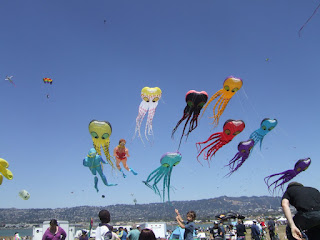A story:
Jim and Martha are in a cafe talking about Martha's upcoming trip.
Martha: I'm traveling to San Francisco via London, Cairo, Istanbul and Mumbai.
Jim: Wow, what an adventurous itinerary. But don't you already live in San Francisco?
Martha: I do. But after the experience of these exotic destinations I will be a different person. I will view my own city and every detail of my life through the lenses of London, Cairo, Istanbul, and Mumbai.
This simple story illustrates why travel is so important to me -- that I see my own life differently after each trip. I savor not only the travel days, but also the planning, the anticipation, and most important now, the aftermath
I traveled 4300 miles with my sweetie in his Prius. Early on we figured out who's to navigate and who's to steer, who's to call the shots about how much money to spend and where to eat, and after that it was all smooth sailing. Every day now, we recall something about the trip -- some horrible incident that we laugh about now, some funny incident that we tell our friends about, or something in the news that relates to one of our destinations. And we will keep talking about the trip and recounting the highlights way into our old age. That's for sure.
I learned a great deal. The trip got me out of my intellectual comfort zone of computers, history, and library science, and got me thinking about the natural world. For instance, I learned that climate change is not just another fad of urban intellectuals, but is visible and measurable in the northern latitudes where we visited. This phenomenon is especially visible through the disappearance of glaciers. We spoke to park rangers, long time residents, and saw photos demonstrating the certain and rapid demise of U.S. and Canadian glaciers. Food for thought.
This was, above all, a journey of scenery. We visited five national parks: Yosemite, Glacier, Banff, Jasper, and Crater Lake. We saw wildlife: elk, mountain sheep, as well as all the little critters and birds. We drove through mountains, forests, deserts, farmlands, rivers, lakes, and waterfalls. We had a feast of wildflowers in Canada. It adds up to a great
humility for the
largeess of Nature, and puts our human contribution to the big picture in perspective.
That said, I have tremendous respect for our forebears who forged lives for themselves in these northern climates before highways and electricity and central heating and wireless internet. For the indigenous peoples who lived well in these harsh climates for thousands of years. For European explorers and settlers who endured physical hardships we can't imagine to make a life for themselves. For the workers who risked their lives to build the railroads and highways through and over mountains in the harshest kinds of climates. Even for the railroad magnates, both in Canada and the U.S., who had a vision to open up the west, and create destination hotels in the most beautiful spots in the world.
We met wonderful people along the way, and a few nasty ones, just like at home. We chatted with park rangers, waitresses, visitor center employees, and fellow tourists. We heard about falling in love and out of love, of missing children at home and loving being away from them, of taking risks in business and the aftermath when it didn't work out, of young people's dreams and old people's dreams.
This journey was also filled with the quiet moments, usually long meals and good wine. Since Jonathan loves to "dine" and I love to try out local wines, long leisurely meals were our way to relax. We visited most of the big hotels in the national parks for a budget meal in an elegant setting. We also looked for restaurants featuring local fare with an elegant twist. Turns out most of the best restaurants in Canada bill themselves as "Mediterranean" though I'm not sure why. We dined at a number of these restaurants, though I usually ordered salmon and local wine -- nothing to do the the Mediterranean. The exception was in Banff where I got one of the best Greek meals I've ever had.
Finally, last stated but most important, is reconnecting with family. This trip was an opportunity to visit with my four Austin cousins -- and their cousins -- all together and as adults. It is unlikely that we will ever convene again, certainly not at my aunt's home, which will soon be sold. Every blood relative is in some sense, a mirror to myself. Though I relate to each of my kin in a different way because they are individuals and so am I, there is another, unspoken connection that is just there. Just because we are kin. Since I've had so little opportunity in my life to know my kin, this convening on the Missoula property was especially meaningful.
Now I'm home and moving on with the activities of everyday life, but somehow in some small way, my Montana Canada trip keeps me company all day every day.

Labels: MontanaCanadaTrip Travel

 s a photo from overhead:
s a photo from overhead:

























